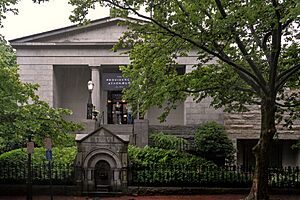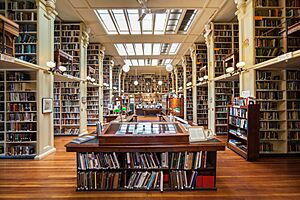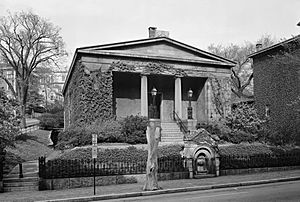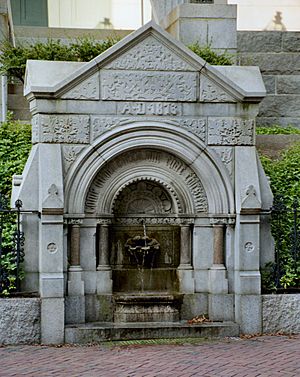Providence Athenaeum facts for kids
Quick facts for kids Providence Athenaeum |
|
|---|---|
 |
|
| Country | United States |
| Type | Subscription library |
| Established | 1836 |
| Location | 251 Benefit Street, Providence, Rhode Island |
| Coordinates | 41°49′33″N 71°24′23″W / 41.8256975°N 71.406499°W |
| Collection | |
| Size | 177 thousand (2019) |
| Access and use | |
| Circulation | 22.7 thousand (2019) |
| Members | 1.89 thousand (2019) |
| Other information | |
| Director | Matt Burriesci |
The Providence Athenaeum is a special kind of library in Providence, Rhode Island. It's called a subscription library, which means it's supported by its members. While anyone can visit the building, only members can borrow books and other items.
This library was created in 1836. It was formed when two older libraries joined together. These were The Providence Library Company, started in 1753, and another library also called the Providence Athenaeum, founded in 1831. The combined library officially became "The Providence Athenaeum" in 1850.
Contents
History of the Athenaeum
How the Library Started
In 1753, a group of people in Providence wanted to read more books. They couldn't afford to buy all the books they wanted on their own. So, they started The Providence Library Company. Members paid a small fee to help buy books that everyone could share.
One important early member was Stephen Hopkins. He was famous for signing the Declaration of Independence. Many of the first books had to be bought from England.
Challenges and Growth
In 1758, a fire destroyed most of the library's books. They were kept at the Providence court house at the time. Luckily, 71 of the 345 books were being borrowed and survived the fire. These surviving books are now part of the Founders' Collection.
When Brown University moved to Providence in 1770, the library let students use its books. In 1836, The Providence Library Company merged with the Providence Atheneum. This new, combined organization became known as the Providence Athenaeum.
Famous Visitors and Authors
On December 23, 1848, a writer named Sarah Helen Whitman ended her relationship with the famous author Edgar Allan Poe inside the building.
Another well-known author, H. P. Lovecraft, lived nearby. Even though he wasn't a member, he often visited the library. He even wrote about it in his letters and stories.
The Library Building
The main building you see today was finished in 1838. It was designed by an architect from Philadelphia named William Strickland. The building is in the Greek Revival style, which looks like ancient Greek temples.
Building Additions
Over the years, the library has grown.
- In 1914, a three-story section was added. This part used to be the Children's Library until 1979. Now, it holds the Reference Room.
- In 1979, another addition was built. This section houses the Sayles Gorham Children's Library, a special place for younger readers.
Artwork and Features
The Providence Athenaeum is not just about books; it also has beautiful artwork.
- A large 18th-century copy of Gilbert Stuart's famous Lansdowne portrait of George Washington. The artist who painted this copy is unknown.
- A small painting called The Hours by Edward Malbone.
- A bronze statue (bust) of author H. P. Lovecraft.
- Marble statues (busts) of important people from the Athenaeum's history.
Outside the library, there's a public drinking fountain called the Richmond Fountain. It was built in 1873 and has a Gothic Revival design. The fountain has a message carved into it: "Come hither every one that thirsteth." After needing repairs, the fountain was fixed and started working again in 2018.
The Athenaeum Today
Today, the Providence Athenaeum continues to be an independent library supported by its members. It hosts many cultural events for both adults and children. One popular event is its salon speaker series, which started in 2006.
Special Collections of Books
Besides the books you can borrow, the library has "Special Collections" in the Philbrick rare book room. These are very old or unique texts, some dating back to when the library first started.
- Founder's Collection: About 70 books from the original Providence Library Company (1753-1836) survived a fire in 1758. Most of these rare books are still part of the collection.
- Archives: These are the library's own historical records, starting from 1753.
- Old Juveniles: A collection of almost 3,000 old children's books from the late 1800s and early 1900s.
- Old Fiction: This collection includes rare books by famous authors like Walt Whitman and Louisa May Alcott. It also has many books printed in Providence and Boston in the 1800s.
- Travel and Exploration: About 2,500 books about travel and exploration from different time periods.
- Natural History Collection: Important scientific books about animals, plants, and other natural sciences.
- Robert Burns Collection: About 450 books related to the Scottish poet Robert Burns, given to the library in 1920.
- Book Arts: Books that are special because of their beautiful design. This collection includes two medieval manuscripts and eight incunabula (books printed before 1501).
Images for kids
-
Bust of H. P. Lovecraft, installed 2013
-
A marble bust of Nathanael Greene
See also
- List of libraries in Rhode Island







